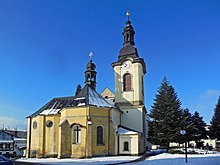Rumburk
Rumburk | |
|---|---|
 Lužické Square | |
| Coordinates: 50°57′6″N 14°33′26″E / 50.95167°N 14.55722°E | |
| Country | |
| Region | Ústí nad Labem |
| District | Děčín |
| First mentioned | 1298 |
| Government | |
| • Mayor | Martin Hýbl (ANO) |
| Area | |
| • Total | 24.72 km2 (9.54 sq mi) |
| Elevation | 387 m (1,270 ft) |
| Population (2024-01-01)[1] | |
| • Total | 10,861 |
| • Density | 440/km2 (1,100/sq mi) |
| Time zone | UTC+1 (CET) |
| • Summer (DST) | UTC+2 (CEST) |
| Postal code | 408 01 |
| Website | www |
Rumburk (Czech pronunciation: [ˈrumburk]; German: Rumburg) is a town in Děčín District in the Ústí nad Labem Region of the Czech Republic. It has about 11,000 inhabitants. It lies on the border with Germany.
Administrative parts
[edit]
Rumburk is made up of the town parts of Rumburk 1, Rumburk 2-Horní Jindřichov and Rumburk 3-Dolní Křečany.
Geography
[edit]Rumburk is located about 30 kilometres (19 mi) northeast of Děčín. It lies in the salient region of Šluknov Hook, on the border with Germany. It is situated in the Lusatian Highlands. The highest point is the hill Dymník at 515 m (1,690 ft) above sea level. The Mandau river flows through the town.
History
[edit]The first written mention of Rumburk is from 1298. In 1377 it is already referred to as a town. In 1566, a Renaissance castle replaced an old keep and Rumburk became the centre of the Tolštejn estate.[2]
Between 1713 and 1764, English merchants settled here and foreign capital has contributed to long-term development of the town. In 1869, the railway was built.[2]
Rumburk was the scene of the Rumburk rebellion in May 1918. Until 1918, the town was part of Austria-Hungary, in the district of the same name, one of the 94 Bezirkshauptmannschaften in Bohemia.[3]
During the Paris Peace Conference after World War I, American, British, and Italian diplomats agreed that the Rumburk corner should be given to Germany for to economic and ethnographic reasons. Eventually, the Conference followed the Czechs' demand based on alleged indivisibility of Bohemia.[4]
In 1938, it was occupied by Nazi Germany and administered as part of the Reichsgau Sudetenland. After World War II, the German-speaking population was expelled and replaced by Czech settlers.
Demographics
[edit]
|
|
| ||||||||||||||||||||||||||||||||||||||||||||||||||||||
| Source: Censuses[5][6] | ||||||||||||||||||||||||||||||||||||||||||||||||||||||||
Economy
[edit]Following a number of years of depression after the fall of communism, the region is now poised to become an industrial centre again. The largest employer with headquarters in Rumburk is Benteler Automotive Rumburk, a manufacturer of automotive parts with more than 500 employees.[7]
Transport
[edit]Rumburk has a road border crossing with the German town of Seifhennersdorf.
The town is the starting point of the regional railway line to Kolín and of two local lines to Děčín (one via Česká Kamenice and one via Sebnitz).[8]
Sights
[edit]

Rumburk has historical centre with many valuable houses. In the town there are also important monuments of folk architecture – half-timbered houses.[9] The area with 18 half-timbered houses is protected by law as a village monument reservation.[10]
The main landmark is the baroque Loreta chapel. It was built by plans of Johann Lukas von Hildebrandt in 1704–1707. It is surrounded by a cloister with a rich ceiling painting from the life of the Virgin Mary, four chapels and a restored Chapel of the Holy Steps (built in 1768–1770). Loreta in Rumburk was an important Marian pilgrimage site for the region of northern Bohemia and Upper Lusatia.[11]
The former Capuchin monastery and its Church of Saint Lawrence were built in 1683–1685. The monastery was abolished in 1950. The valuable building now serves as a library. The church still serves cultural and religious purposes.[12]
The original wooden Church of Saint Bartholomew was built in the late 12th or early 13th century, the oldest written mention dates from 1352. The building was severely damaged by fires in 1515, 1624 and 1744. Its current appearance is from the reconstruction in 1755.[13]
Notable people
[edit]- Johann Nepomuk Fischer (1777–1847), Austrian ophthalmologist
- Josef Emanuel Fischer von Röslerstamm (1787–1866), Austrian entomologist
- Franz Xaver Chwatal (1808–1879), pianist, composer and music teacher
- Viktor Tietz (1859–1937), German chess player
- Rudolf Pitschak (1902–1988), Czech-German chess master
- Helmut Baierl (1926–2005), German playwright and vice president of the DDR Academy of Arts
- Jaroslav Falta (1951–2022), motocross racer
References
[edit]- ^ "Population of Municipalities – 1 January 2024". Czech Statistical Office. 2024-05-17.
- ^ a b "Historie Města Rumburk" (in Czech). Město Rumburk. Retrieved 2021-07-14.
- ^ Die postalischen Abstempelungen auf den österreichischen Postwertzeichen-Ausgaben 1867, 1883 und 1890, Wilhelm Klein, 1967
- ^ Goldmann, Rüdiger (1971). Die sudetendeutsche Frage auf der Pariser Friedenskonferenzpublisher=Fides-Verlags-gesellschaft (in German). p. 89.
- ^ "Historický lexikon obcí České republiky 1869–2011" (in Czech). Czech Statistical Office. 2015-12-21.
- ^ "Population Census 2021: Population by sex". Public Database. Czech Statistical Office. 2021-03-27.
- ^ "Registr ekonomických subjektů". Business Register (in Czech). Czech Statistical Office. Retrieved 2024-03-23.
- ^ "Detail stanice Rumburk" (in Czech). České dráhy. Retrieved 2024-03-23.
- ^ "Památky" (in Czech). Město Rumburk. Retrieved 2021-07-14.
- ^ "Vesnická památková rezervace v Rumburku – soubor podstávkových domů" (in Czech). CzechTourism. Retrieved 2022-05-26.
- ^ "Loretánská kaple s ambity" (in Czech). Město Rumburk. Retrieved 2021-07-14.
- ^ "Kapucínský klášter u sv. Vavřince" (in Czech). Město Rumburk. Retrieved 2021-07-14.
- ^ "Kostel sv. Bartoloměje" (in Czech). Město Rumburk. Retrieved 2021-07-14.



